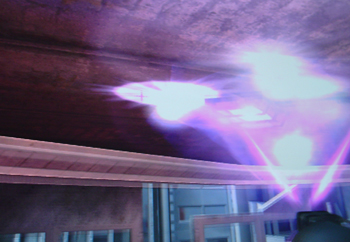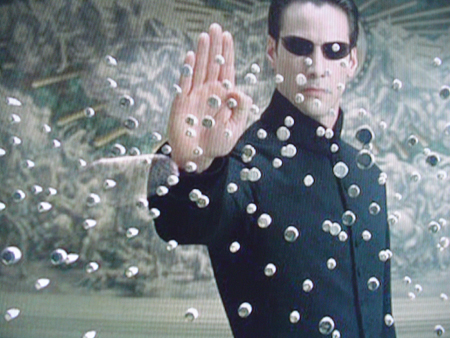A Guide to Choosing the Right 19" LCD Monitor - 7 Models Reviewed
by Kristopher Kubicki on November 30, 2004 12:04 AM EST- Posted in
- Displays
Application Analysis
The core of our LCD benchmarking comes from real application analysis. We play with a lot of monitors and it gets easier for us each time to pick out problems with an LCD just by using the right application. Here are a few quick looks at some demanding full screen applications. We already ran ColorVision's OptiCal software, so all of our monitors are calibrated and adjusted to the same curves.High Definition Video - We cheated a little bit on this portion of the analysis and handicapped all the monitors. None of these LCDs can display a true HD signal correctly without compressing pixels or cropping the image. Nevertheless, we set out to play a WMV9 1080i signal on our monitors with the interest in looking for color differences. Since our monitors have all been precalibrated, we expect the same image on each screen. Unfortunately, no amount of calibration can fix some things; we still noticed "off" reds on most of the monitors (including the Samsung 193P, the Sony, the Planar and the Dell). The BenQ, NuTech and ViewSonic occasionally managed to wash out blues a little too easily, and when looking in the right places, we could easily spot some of the differences between the 6-bit BenQ image.
The Matrix Reload, The Matrix - We use the Matrix series to test full motion video on our LCDs. Since the Matrix isn't the best movie to test color reproduction, we typically only look for motion blur or other imperfections. As expected, we noticed no fatal flaws in any of the LCDs. Although, while running some of them side by side, it became readily apparent that some monitors put a slight hint of color on the application - noticeably, the NuTech and ViewSonic monitors had a slight bluish tint.
WarHammer 40K, Dawn of War - When looking for a monitor's response time, we generally only consult first-person shooters for reference. However, those of you who have played a fast-paced game of Warcraft III or NeverWinter Nights will know that scrolling around for hours puts a severe tax on the monitor. Although we didn't notice any profound difference on the 16ms BenQ monitor, we could tell that the Sony and Planar had occasional difficulty in poorly lit areas of the game. For example, when scrolling around the last level of DOW where the majority of the level is gray ash and black soot, we would see the edge of the menu bar and status icons bleed into the ground.
Looking closer, we noticed some small differences with heavy weapons fire while scrolling on the BenQ FP931 and Samsung 193P. With enough patience, we can actually count the tracers shot over long distances, but when viewing the same scene on the Planar PE191M, the same task seems almost impossible. Attempting to do the same on the ViewSonic LCD proves futile sometimes, but not others.
Max Payne 2 - The extreme light and dark transitions in Max Payne still provide us with the sufficient criteria to benchmark transient response time; specifically, we can focus on the light and dark extremes. However, in all of the demos that we ran, we noticed virtually no difference from one monitor to another. The Samsung 193P looked a little more vibrant than its competitors, but the NuTech and ViewSonic models were displaying particularly brighter lights while maintaining the same dark hues as the SyncMaster 193P. Revisiting Max Payne with the Dell 2001FP was a little bit of a surprise. Even with the brightness set to its maximum, we were a little surprised at how much brighter the 19" LCDs were running.
Halo, Unreal Tournament 2004 - Halo and UT2K4 have very similar results, but now, we are looking for fast motion and color correctness at the same time. Again, we noticed a slightly blue tint to the BenQ monitor even after it was corrected with OptiCal. All of the monitors had a tendency to wash out, particularly in bright areas, and part of that is because we are running all of our monitors at the highest brightness levels. Specifically, the BenQ and Samsung 910V would wash out especially in bright explosions (a well-placed Redeemer usually did the trick). On occasion, the Sony SDM-934 and the Planar PE191M would blur in heavy laser battles (4 or 5 shock rifle shots firing across the screen would usually leave a small trail).

ViewSonic Q190MB
Click to Enlarge.














97 Comments
View All Comments
benk - Tuesday, November 30, 2004 - link
I just (like two hours ago) got my Dell 2005FPW...played an hour of CS:S. Didn't notice any ghosting, blacks were all black, etc. I have my desktop set up stretching across this LCD and my old Sony Trinitron 17" and the color and sharpness on the LCD is markedly better. It actually surprised me; I thought I was giving up color in trade for a wider monitor that's a little easier on the eyes. Nope. It looks great, plays great, and, according to my girlfriend, is lots more stylish.IceWindius - Tuesday, November 30, 2004 - link
Screw LCD, SED is the wave of the future.Until then, i'll stick with my Viewsonic CRT monitor, thank you.
archcommus87 - Tuesday, November 30, 2004 - link
Can anyone go back to the issue that someone asked prior about running non-native resolutions? My biggest deterrent about LCDs was always the fact that if I run my desktop at 1280x1024, I have to run all of my games at that, too. Sorry, but unless I'm buying two video cards a year, that's sometimes hard to do.Can you use other resolutions without getting crappy images?
Yes, at times I have considered selling my 19" and 17" CRT dual monitor setup for one, single 19" LCD. But then I think, nah I love my Philips, and two monitors is cool. Plus I'd hate to have to run all my games at such a high res.
nullpointerus - Tuesday, November 30, 2004 - link
Cat: The lower the refresh rate on the video card, the more sluggish the mouse feels to me. Anything below 75 Hz feels terrible. Setting it up to 100 Hz (assuming your card and display support it) feels extremely fluid. I'm just suggesting possibilities, so YMMV.TCfromNL: From what I can tell, the article doesn't make any such claims about whether you have problems if the GIF appears dithered on your display; it's just presenting a visual aid.
coldpower27 - Tuesday, November 30, 2004 - link
It depends on each peoples eyes, I guess it's not quite as noticable to some. Also not all the 25ms screens are created equal.I have a 25ms LCD, and I don't really notice ghosting, I got it over 2 years ago, though when it cost alot. Though 25ms for an LCD to do continous motion as that enough to generate 40FPS, I also don't really play that many FPS. The new LCD's that are capable of 12ms are amazing that like double the FPS at maximum.
Yeh it would have been nice to test some of the newer LCD panels as well, but to me I don't know why people want it so bright, my LC is around 350:1 range and I already fine that awfully bright, 800:1 just seems so much :S
drinkmorejava - Tuesday, November 30, 2004 - link
I'm confused, how can all those 25ms monitors have no noticeable ghosting. I've always known that a black-white measurement does not truly show how much ghosting there will be, but a 5?TCfromNL - Tuesday, November 30, 2004 - link
Okay. Small problem with the 256-shades-of-blue thing, referred to as "the image below".Since it's a GIF, it only contains 256 shades of color, tops. Including all the greys.
I imagine you have a losslessy (or un-)compressed 24-bit copy somewhere. Still, it's not nice to scare your readers by displaying some 20-shades-of-blue thing while saying that if it doesn't display smooth as a baby's skin, which it doesn't, the viewer's monitor is at fault.
Further, nice article. But since these monitors are all 1280x1024 (except for the 20" Dell), I can't help but leave disappointed. I don't like squarish monitors. There's a reason why TV evolved from 4:3 to 16:9. I agree with the cry above: IT DOES NOT MAKE ANY SENSE.
gwynethgh - Tuesday, November 30, 2004 - link
Now to find a good but reasonably priced DVI KVM switch.KristopherKubicki - Tuesday, November 30, 2004 - link
Klah: have they benchmarked any units using that methodology except the example? I checked around and couldnt find any.Kristopher
klah - Tuesday, November 30, 2004 - link
"klah: I was only aware of Xbitlabs doing so. We feel that the methods for measuring reponse time thus far are OK, but not represent gray to gray response time measurements well. Its something we are working on and we will probably have a better methodology before the next roundup.Kristopher"
Here is Tom's methodology:
http://graphics.tomshardware.com/display/20040923/...